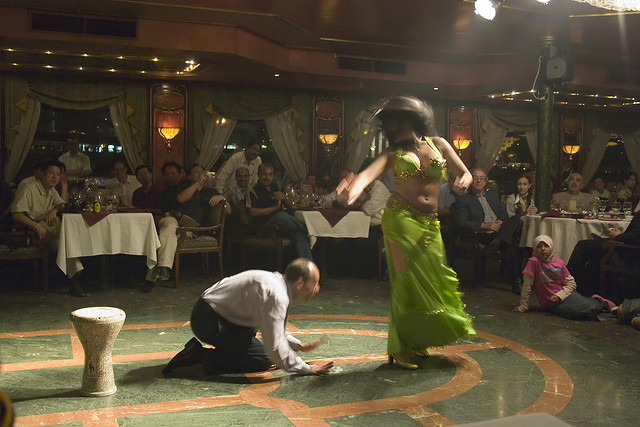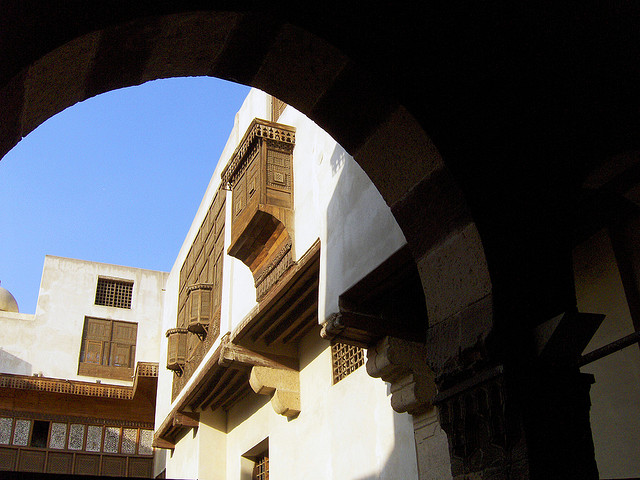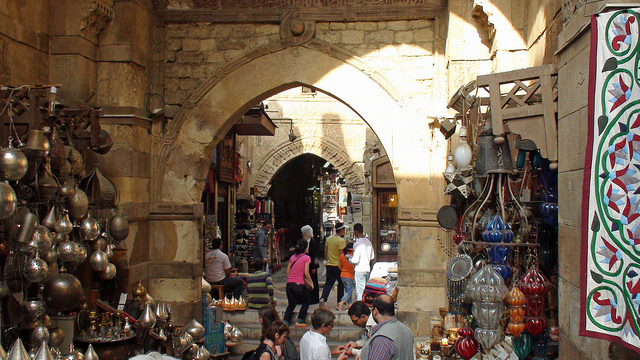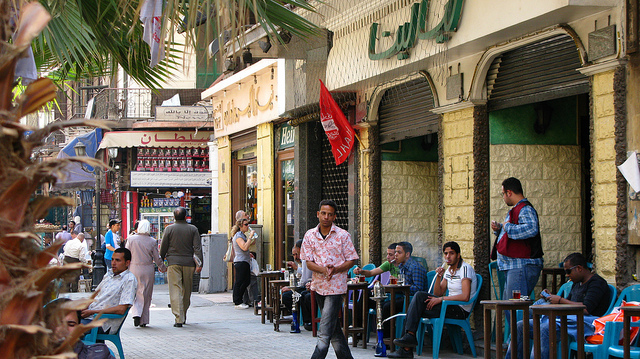I have always been fascinated with Cairo. I'd read The Cairo Trilogy by the Nobel Prize winning author, Naguib Mahfouz, and I loved the music of Uum Kalthoum and Abdel Halim Hafez.
When I first arrived in the city on a late afternoon in June 2002, I couldn't believe the contrasts – new apartment buildings, old dusty apartment buildings crumbling along the roof. Streets were crowded with small cars. Along the side of the road were occasional slow-moving horse drawn wagons, heaped with produce. They were driven by men and boys wearing long light blue galabeyas and white caps.
[social]
Right by a city street, a postage stamp sized field and little vine covered shack squeezed in with the bright green banks of a canal. Coming around a dusty wall, there appeared the huge dome of a tomb of the Mamluk era, completely covered with interlocking shapes of beautiful carved stone. Everywhere people were yelling, joking, walking purposefully; a city filled with energy. A huge herd of camels went running by on a side street! A little later, we crossed the Nile itself, just as I'd imagined it, shimmering in the late afternoon light, lush and green along its banks.
BootsnAll is about independent travel. When I traveled to Cairo, I was part of a group. However, many days I spent with a guide I hired. In that sense my experiences are relevant to this website.
>>book a cheap flight to Cairo and read our Egypt Travel Guide
For my last two trips, the group was led by Morocco of New York, the famous dancer. We went to the Ahlan Wa Sahlan dance festival – five days of dance classes and performances by Egyptian teachers of Raks Sharki (commonly called by the misnomer "bellydance", attended by dancers and dance afficionados from all over the world (including a surprisingly large number from Japan). Evening performances were accompanied by excellent live Egyptian bands, a treat for any lover of Arabic music.
The festival was held at the Mena House Hotel, once the hunting lodge of the Khdive Ismail, who was the last Ottoman ruler of Egypt. It was a swankier hotel than I would usually select, but part of it is very old and historic. During the week before the festival, our group stayed in the Hotel Victoria, built in 1928, a cozy little hotel near the old part of the city. When you opened the windows at night, you could hear the lovely call to prayer, reverberating from different mosques around.
Most tourists in Egypt are taken to see the ancient wonders of the time of the Pharoahs. I wanted to visit a few of the beautiful medieval buildings I'd read about in my guidebooks. I hired a man who was recommended by my friend, Leyla, a California dancer/instructor whom I'd met through an internet list.
This old architecture is incredible, for me one of the most beautiful anywhere. I like old mosques, many built during the Mamluk era. You step off the crowded streets into a quiet space, inlaid with patterns of stone mosaic, graceful arches above. My favorite is the el Ghuriya mosque, across the footbridge from a shop that sells white garments for people to wear on the Haj to Mecca. El Ghuriya is relatively small, built of inlaid white and black stone in beautiful ornate patterns, with lines of gorgeous black and white calligraphy in the Kufic style.
There are also a couple of restored large homes of that era, which I enjoyed visiting. The Gayer Anderson House, once owned by a British ex-pat, houses his collection of art items from the Middle and Far East. The Bayt Suhaymi has been restored to what it was like when a rich Muslim merchant lived there in the 1800's. I also liked the restored caravanserai where the camel caravan merchants stayed when in town.
I climbed the Bab Zuweila, one of the old gates of the city. I looked down over the ramparts, just as the sultans once did when they bid farewell to those departing for the yearly pilgrimage to Mecca. Ten percent of Egyptians are Coptic Christians. We visited their Coptic church, also ancient. It was Sunday morning and the chanting was spectacular.
People living in Cairo have the reputation of being friendly – one characteristic I liked immediately. The culture is animated. Women and men tease and joke a lot. It seems less of a "macho" culture than at home in Arizona, though most of my friends do not believe me when I tell them this. A typical example of an Egyptian kidding around is to have a waiter pretend he's about to spill coffee on you, and then say "just kidding". I found the best way to interact with Egyptians was to get into this kidding mode, even if it seemed silly. Most Egyptians do not appreciate a "serious" personality.
It's true the sheer number of people can be overwhelming; traffic is hair raising, pollution is getting worse. Cairo is inundated with poor country people looking for some way to make a living. I didn't see many beggars or people who looked like they were not getting enough to eat, but there were a large number of shoeshine boys, many youths hurrying around with trays of teaglasses, delivering to the different shop owners.
There is a general feeling of mistrust for the U.S. government, but it is not translated into dislike of Americans as people. When asked where I was fron, I always answered, "Amriika, but I don't like George Bush". This went over well. (I'm aware some of the friendliness is due to the need for tourist business).
Women on the street wear long sleeves, long skirts and headscarves. There are many middle class women who don't cover their heads most of the time, but they are not walking around outside. My friend, Leyla, said there is more pressure now for an Egyptian woman to cover herself. Our guide's wife used to dress in western outfits, but started getting more and more pressure from neighbors until, around five years ago, she began dressing conservatively.
I always wore long sleeved, high-necked tops and long skirts. I carried a headscarf at all times so that I had a head covering when I visited a mosque, or while walking past a demonstration against the U.S. These demonstrations take place on Friday mornings, in Hussein Square, between the two most holy mosques, El Hussein and El-Azhar, when worshipers come out of the mosques and fill the square. Loudspeakers trumpet sermons and the word "Amriika" is voiced in an angry tone. Lines of police vans and black-uniformed police hem in the demonstrators so they can't be seen. A few hours later, the square is "business as usual", buzzing with shops, cafes, tourists, locals.
As more women take to Islamic dress, it has developed its own fashion trends. You see groups of teenage girls in long-sleeved fitted T-shirts with hip slogans, long flared denim skirts that fit snuggly around the hip, and the latest in headscarves – two colors of chiffon wound around the hair and neck, pinned in a fetching style, often lime green, hot pink or other trendy color, layered with white.
In the evening and late into the night, the cafes along the edge of Hussey Square put out tables and chairs, filled, especially Friday night, with groups of chattering Egyptians in a happy mood. Here and there someone is drumming, playing an oud or strumming a guitar, and a little girl will be dancing on a table to the clapping encouragement of her family. The whole area is alive.
We went on a felucca, a small sailboat of ancient design, after dark on the Nile. There were small boats, strung with colored lights, people had hired for parties, playing Arabic music turned up full blast. The quiet boy sailing the felucca let out the burlap sail and the boat really moved! Along the banks, the lights of the city were reflected. As we reached the shore, a wedding party was coming down a wooden ramp to a large lighted barge, near the mud bank where we docked. A male stick-dancer danced backwards before the bride in her western-style bridal gown. Her escort was in a suit, followed by drummers, singers (all wearing galabeyas and turbans) and family members.
There is an amazing dervish show held nightly in a large courtyard of a building in the old part of town. The musicians are good and they have a lot of attitude and flash. It's worth seeing. Don't go when you are very tired, though, the continuous whirling of the dervish dancers in their bright colored skirts will put you right out!
We spent a day shopping in the Khan el Khalili, the great souk of old Cairo – the centuries old gold souk, a warren of tiny passageways through an area as big as a city block, lined with small gold shops. These places sell wholesale to shopowners all over Egypt. The work in the lane known as the Tentmaker's Bazaar is meticulous, patterns ornate and strikingly colored. Small ones make great gifts and the large ones are good wall hangings.
There are cafes all over Cairo, some where only men hang out, others frequented by families and mixed groups. One of the most famous of the latter type is Fishawi's, in the middle of the souk. It is always full of people – more Egyptians than tourists. Once, two friends and I stopped there with our guide during the slow part of the afternoon. We ordered tea and coffee. The waiter rushed to bring shiisha, waterpipe. As the waiter walked away, he hummed an old Egyptian song, Ghanili Shwaaye Shwaaye". He was surprised and pleased when I joined in. Later he hummed another song, Salamit-ha Oumu Hassan". I joined in on that one too. I only knew two Egyptian songs at the time, and the waiter happened to sing those two!
I'm not one to shop around for the best price. If I like something, I'll buy it. Although our guide added ten percent to the price, it was still worth it because he could get a better price than would be quoted to a tourist.
Here is something to remember in Egypt or any Arab country. It is considered very bad luck to give a compliment without saying Ma sh 'Allah, with the help of God. Leaving this expression out raises the specter of the evil eye, taken very seriously in Egypt and much of the Arab world. Say Ma sh'Allah, what a beautiful child, or Ma sh'Allah, what a beautiful home. The future should be accompanied by insha Allah, God willing, as in "We meet tomorrow at eight, insha Allah.
Many people travel independently in Cairo. I feel more comfortable with a group. Some Western women explore on their own with no problems. Others have experiences with cab drivers who keep driving around even after they've reached their destination. Sometimes they won't drop you off until you pay more than the agreed-on price. I have decided, as a 58-year-old woman, to hire a guide. It's well worth the expense.
Here's something else to be aware of. Behavior which a Western woman considers casual flirting, even casual friendliness, can be perceived quite differently by an Egyptian man, especially one who has had no experience in Western countries. Dating, as we know it, does not take place in Egypt. When you see couples, they are almost always engaged to be married, waiting to be able to afford their own apartment. The housing situation in Cairo is packed. Rental laws leave the market tight, with few rentals available. When you come upon women, they are more often in groups.
The cell phone has changed socializing between teens in Egypt. Boys don't call girls (it could get the girl in trouble). Girls can call boys, though, and do – a lot! Our guide's son goes to a local night spot where groups of girls and groups of boys come together. But they leave with the group they came. If a Western woman accepts a "date" with an Egyptian man, she can be asking for trouble and she can make it difficult for the man too. One waiter lost his job over such a situation.
If you like Arabic music and culture, yearn to go to the Middle East, you'll like Cairo. If you have a hard time with noise, crowds, cigarette smoke and traffic, and do not have a good sense of humor, it may not be your kind of place. But you may love it – as I do.
Read more about Egypt:
- Egypt’s Safe for Tourists…Really!
- Valley of the Whales – Fayoum Province, Egypt
- Land of the Pharaohs
- Wandering Through Chaos: A Brief Look At The Hectic, Eccentric Side Of Egypt
Photo credits:
Bellydance by Christopher Rose on Flickr
Bayt Suhaymi by flyoverstate on Flickr
Coffee shop by Motor-Head on Flickr
Souk by Michel27 on Flickr



